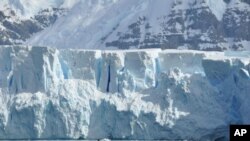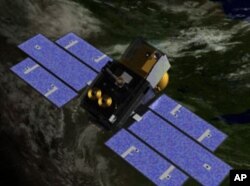Warm water, and not warm air, is speeding the accelerated ice melt in Antarctica, according to a new study in Nature.
The study's lead author, Hamish Pritchard, is a glaciologist with the British Antarctic Survey. In 1993, and again in 2003, he observed the collapse of two ice shelves on the Antarctic Peninsula. He says the glaciers they had been holding back picked up speed and flowed six times faster than normal into the Southern Ocean.
When Pritchard’s team deployed satellite laser instruments to measure changes in the Antarctic ice shelves between 2003 and 2008 they saw a distinct pattern.
“Some of the ice shelves were lowering quite strongly," he says, "and in particular those were the ice shelves in west Antarctica.”
Previous studies looking for the causes of the shrinking ice shelves had ruled out decreased snowfall or any slow-down in the movement of glaciers toward the sea.
Pritchard says the new data points to a process they call “basal melt:” warmer ocean water heating the ice shelf from below.
“We looked at 54 ice shelves around Antarctica and of those, 20 were thinning by this process. Going beyond that we found in every case where we saw this ice shelf thinning by basal melt, we also saw thinning by acceleration of the glaciers that drained from the ice sheet.”
Pritchard says stronger westerly winds in the Southern Ocean are driving warmer ocean currents closer inland to ice shelves on the Antarctic coast. “It tells us that the ice shelves can be very sensitive to quite subtle changes in the climate, such as the wind patterns, that we hadn’t really appreciated before.”
Jan Gunnar Winther, director of the Norwegian Polar Institute, is not affiliated with the study. He says the research provides important new insight into how climate change-induced melting of the Earth’s polar ice sheets is affecting global sea levels.
“In very many places around the world, most places where you have glaciers, and in Greenland, in parts of Antarctica, not in all of Antarctica, they add to the global sea level and they may already be, from what we know, the most important explanation of why we have an increased sea level."
Winther says emissions from fossil-fuel combustion in our power plants, cars and buildings continue to pump global warming gases into the atmosphere. As Prichard and colleagues note in their Nature study, these warming trends are driving wind and ocean current changes that are speeding up the melting and thinning of Antarctic ice.
That dynamic appears to be self-sustaining, the researchers warn, concluding that it “may have already triggered a period of unstable glacier retreat” across the western Antarctic ice sheet.









